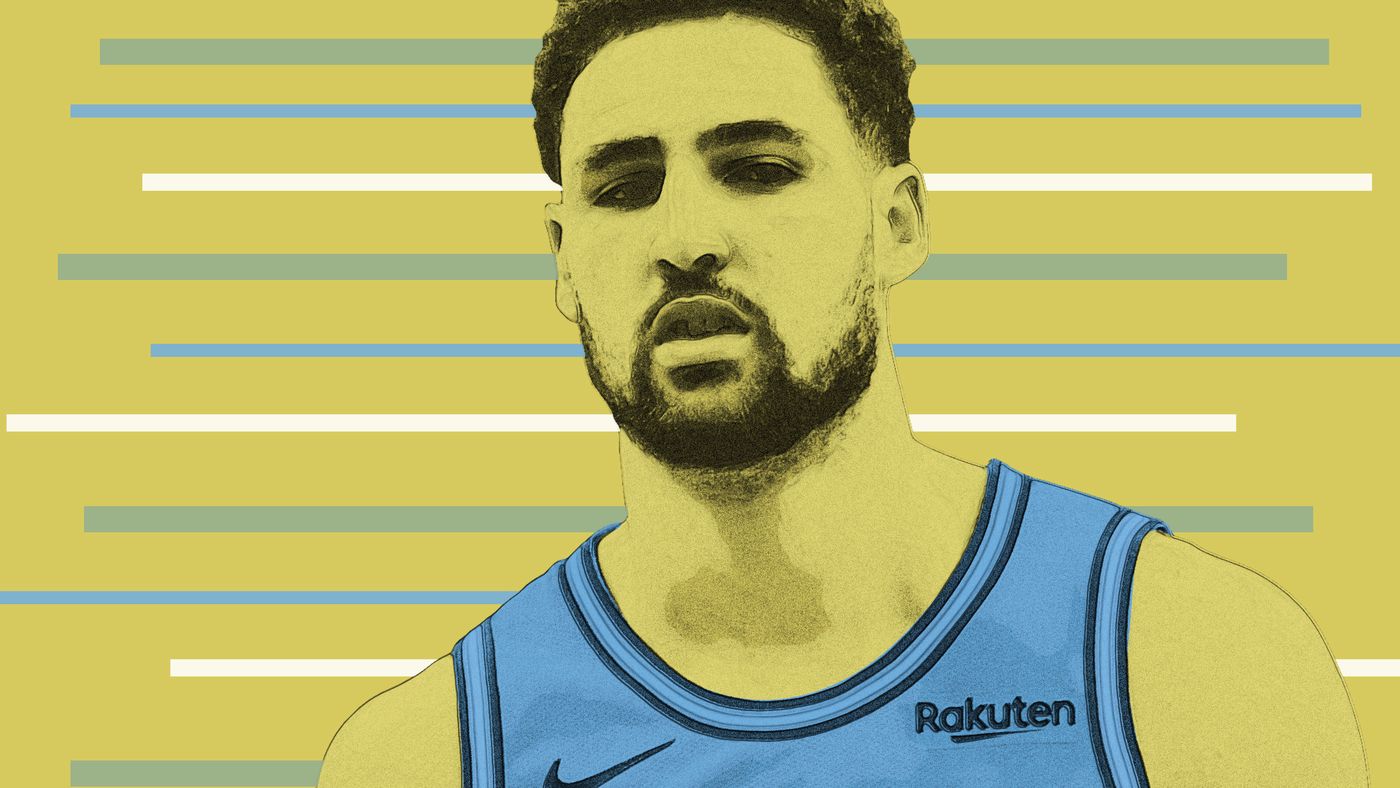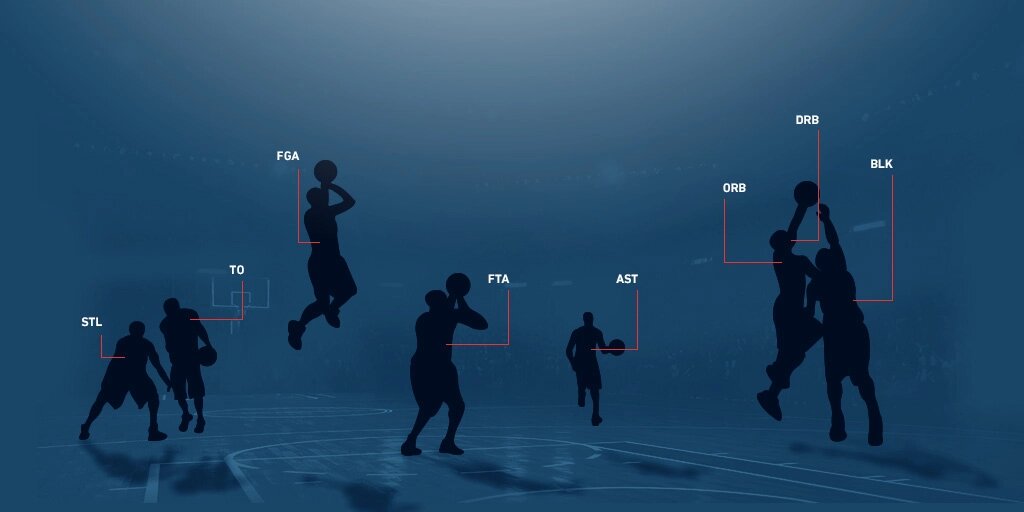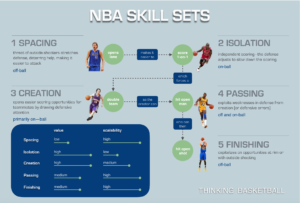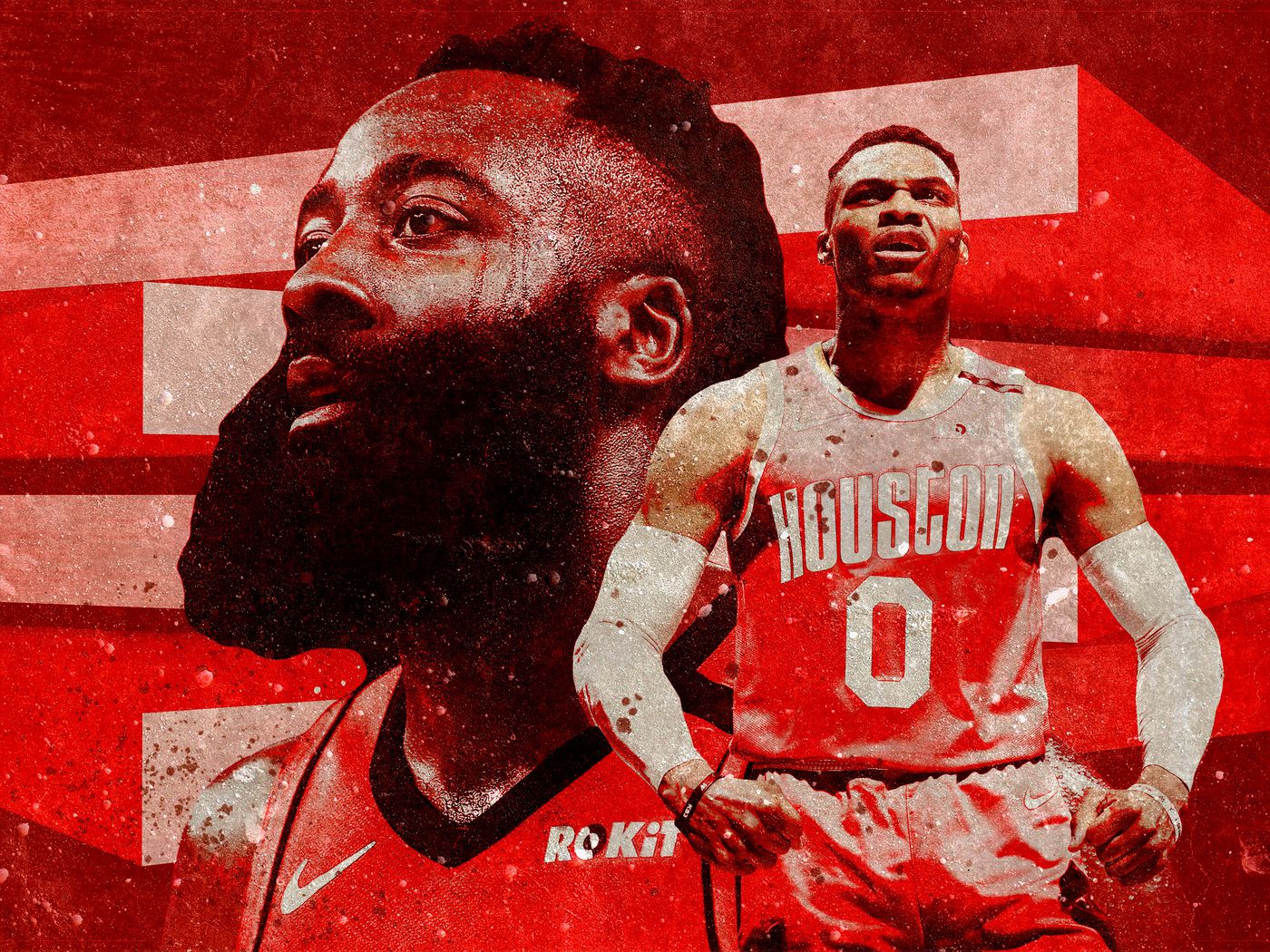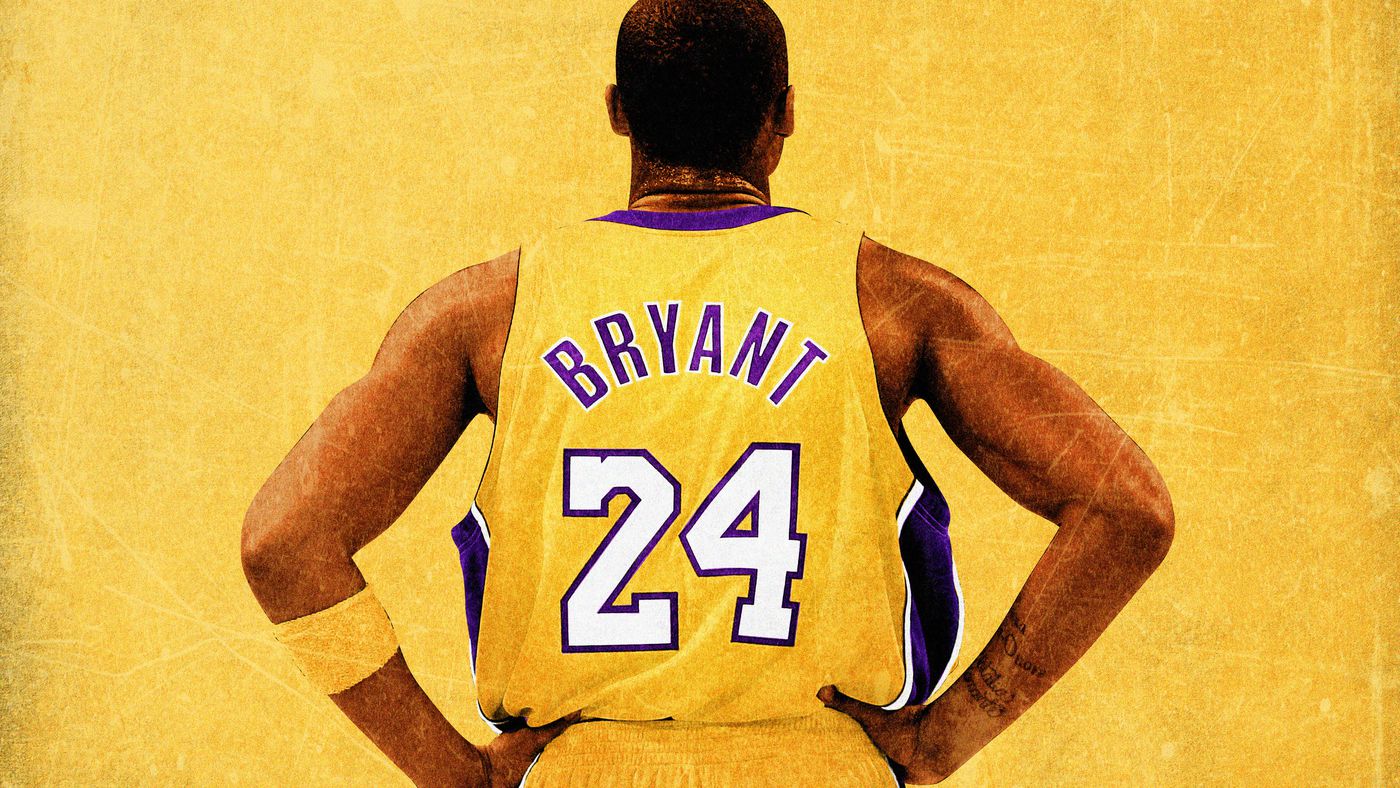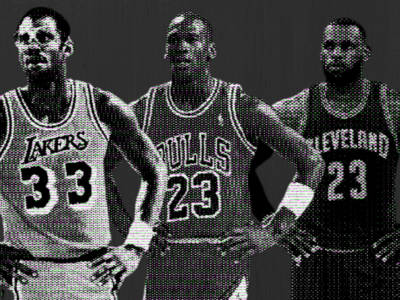Determining the best scorer in the NBA; it’s an intriguing premise and for good reason. Individual scoring is the most direct way to positively influence the scoreboard, and proficient scorers generally contribute higher amounts of value on random teams. I’ll be attempting to answer the aforementioned question to, hopefully, provide a solid framework through which we can further examine the league’s top scorers.
– Rationale –
The elements of scoring are properly tracked through visual and analytic principles, both of which were employed in compiling this list. The former more strongly relates to a player’s scoring “arsenal,” or the various ways a player scores within his traditional efficiency and volume stats. This includes observing different types of scoring moves, for example, floaters, fadeaways, and step-backs. However, the most relevant application of visual methods is examining a player’s off-ball scoring, a field unmeasured by statistics, that acts as one of the defining aspects of a player’s scoring repertoire. The presence of visual deductions is key in adding key context to a player’s scoring arsenal and incorporating what can’t be measured.
Statistics will play an important role in measuring scoring proficiency as well. The traditional measurement of scoring volume is represented as “points per game” (PPG). In place of PPG, I’ll use “points per 75 possessions” (PTS/75), a stat that takes playing time and team pace into account to add context to the conventional measurements. Similarly, True Shooting Percentage (TS%) will be used in place of traditional shooting splits (FG% – 3P% – FT%). It’s noted as a superior efficiency measurement to the typical shooting splits taken together, and TS% can be more easily compared across seasons through Relative True Shooting (rTS%). The other widespread statistics I’ll use are free-throw percentage and three-point percentage to solely measure free-throw proficiency and three-point accuracy, respectively.
Proprietary data, provided by Backpicks, was also used to determine the scorers on this list. Listed below are the metrics that were taken into account, their abbreviations, and what they measure.
- 3P Proficiency (3P Pro): an estimate of three-point scoring proficiency combining both efficiency and volume
- Scoring Turnover Percentage (sTOV%): the percentage of Offensive Load that comes from scoring attempts
- Scoring Value (ScoreVal): an estimate of the number of points per 100 possessions a player contributes through scoring
- True Scoring Percentage (TSc%): a measurement of scoring efficiency factoring “scoring turnovers”
I’ll cite these metrics regularly throughout the player profiles. However, since this group of stats consists of proprietary measurements, I’ll more frequently depict them through percentiles instead of actual scores. The distributor of these metrics typically releases certain amounts of its proprietary data in the form of percentiles. This way, the metrics can be put into proper perspectives while respecting the data’s privacy. I’ll include a series of bullet points for each player that illustrates their strengths and/or weaknesses, providing a brief summary of a player’s scoring proficiency and repertoire. As is with every list I make, the purpose of today’s ranking is less centered around the specific placements and more the exchange of data and deductions on the league’s top scorers. Resultantly, I’ll include a series of ranges (an idea inspired by Ben Taylor), or how much higher or lower I could see a player ranked based on how competitive the playing field is, underneath each player’s summary.
5. Karl-Anthony Towns, Timberwolves
Towns’s name rarely enters the conversations on the league’s top scorers, yet he makes a relatively strong case. Minnesota’s star center possesses a three-dimensional scoring repertoire that starts with his interior play. Towns is tall and sturdy enough to compete with traditional big men, but his surprising agility and swiftness can dismantle opposing guards as well. His put-backs are relatively strong; Towns’s verticality can counter multiple defenders in the paint. His back-to-the-basket arsenal is increasingly proficient. Towns uses it to his advantage for passing, although it also serves well toward a strong post game, often resulting in quick turn-around jumpers. The strongest aspect of his scoring repertoire is his three-point shooting. Towns operates on the perimeter and weaves through opposing defenders like a guard. His quick form, seemingly just a flick of the wrist, created arguably the greatest-shooting center in league history. Towns is noted for his step-back three-point shot, which paired with his aforementioned long-range strengths, paints him as one of the premier outside shooters in the entire NBA.
The value of Towns’s scoring is similarly reflected through his statistics. I calculated three-year weighted values of different scoring statistics with weights of 57.1% for a player’s most recent season, 28.6% for the prior season, and 14.3% for the season prior to that. Towns has a weighted scoring volume of 26.3 points per 75 possessions, which would rank in the 96th percentile (volume) among current players. His strong efficiency was a determining factor in his being here; Towns posted a weighted +7.5 rTS%, which when normalized to 2020 values, would stand in the 94th percentile (efficiency). However, the two most impressive figures in my eyes are his single-year 3P Pro (95th percentile), which matches his weighted score, and his league-leading ScoreVal this season, a mere two-tenths of a point lower than his weighted value. Towns elevates the Minnesota offense despite playing alongside a lackluster roster. The team’s Offensive Rating (ORtg) rises +12.22 points with him on the floor versus off the floor per PBP Stats. Towns makes a case as the league’s premier scorer this season, hence his fifth-place finish.
Summary
- Strong in interior play with a diverse arsenal
- Mobility counters guards and big men effectively
- Operates on the perimeter like a wing player
- Arguably the greatest shooter at his position ever
Although his proficiency as a scorer this season is enough to guarantee a spot on the list, I see the argument that he drops out of the top five to make way for a different candidate, like Kawhi Leonard. Towns has yet to garner enough Playoff experience to paint a clear picture of his second-season equity, a field Leonard excels in. Leonard’s three-year Playoff ScoreVal is higher than all notable current stars, including Stephen Curry and LeBron James, except for Kevin Durant. Leonard’s regular-season scoring is also quite close to Towns’s, but the latter’s superior floor-spacing and efficiency were determining factors in his selection over Leonard. On the other hand, I could also see Towns rise one spot to land in fourth. His weighted efficiency, spacing, and free-throw scoring are prominently superior to his successor on the list, and as a result, Towns makes a reasonable case to move up one spot. However, I see him most properly placed as the league’s fifth-most proficient scorer.
4. Giannis Antetokounmpo, Bucks
The Greek Freak, Giannis Antetokounmpo, has evolved into one of basketball’s premier scorers in the last three seasons. To understand his scoring prowess, one must be familiar with his interior and transition play. Antetokounmpo’s half-court scoring is driven by his athleticism and length. He weaves through multiple defenders when slashing en route to fruitful attempts at the rim. The Greek Freak’s verticality begets the end result of these attempts, with his 7’3″ wingspan guiding the ball into the hoop with frequency. Antetokounmpo’s transition proficiency equally models his aforementioned abilities. It’s among the league’s greatest individual skills; one of his strides covers arguably more ground than any other player in history. The Greek Freak generates 9.3 points per 75 possessions on transition plays with a 63.0 eFG%. He also leads the league in Real Adjusted eFG% (+2.39), a measurement of how efficiently a team scores with a player on versus off the court. Despite his massive strengths, he has little to no outside shot. Antetokounmpo converted on an adequate 39% of his mid-range attempts this season but stands in the 1st percentile in 3P%, the second-lowest mark in the league. Antetokounmpo dominates the paint and transition opportunities and, conversely, displays gaping holes in his scoring repertoire. Regardless, the Greek Freak remains a world-class scorer.
Antetokounmpo was the highest-volume scorer of the season, despite lacking the potential to win this year’s scoring title. He played a mere 30.8 minutes per game, during which he managed to score 29.5 points. This translated to a league-leading 33.2 points per 75 possessions, surpassing the perennial scoring champion, James Harden. The Greek Freak is also one of the league’s most efficient scorers; he’s in the 90th percentile in weighted rTS%. Antetokounmpo’s most efficient area of scoring is close to the basket; he makes 73% of his shots at the rim (92nd percentile) on 11.5 attempts per 75 possessions. Despite his aforementioned three-point deficiencies, which paint him as arguably the worst shooter in the league, Antetokounmpo’s floor-spacing is considerably greater. Factoring in the number of attempts he takes from long-range, the Greek Freak is in the 34th percentile in 3P Pro, a significant increase compared to his standard percentage and a +6 increment from last season. Antetokounmpo may never grow into an elite, let alone good, outside scorer, but his improvements are sufficient in recognition as one of the league’s top-four scorers.
Summary
- Historically-great weapon in transition
- Near equally proficient in the paint
- 100th percentile-level scoring volume
- Lack of outside shot holds him back
Antetokounmpo is a unique case among the players on this list. His efficiency, volume, and overarching scoring value seem adequate to propel him to a higher spot, but his lack of an outside shot is the main hindrance in doing so. As stated earlier, these deficiencies are enough for me to see him drop back to the fifth spot, but no lower. The Greek Freak’s league-leading volume and positive efficiency (as well as a 100th percentile ScoreVal), in my eyes, prohibit a further drop. Conversely, I don’t see the argument for him to rise any higher. The subsequent players on this list display similar volume and efficiency with the three-point proficiency that Antetokounmpo lacks. The range most fitting for the Greek Freak, in my eyes, results in his placement as the fourth or fifth-best scorer in the NBA.
3. James Harden, Rockets
James Harden was the recipient of the last two scoring titles and is due for his third by the end of this week, and for good reason. He’s noted as one of the NBA’s foremost isolation scorers, anchoring perennially-great Rockets offenses. Harden averaged 1.13 points per isolation possessions (92nd percentile) this season, translating to a generated 15.2 points per 75 possessions on these plays. He usually begins these possessions at the perimeter, where he dances with opposing defenders with his routine between-the-legs dribbling montage. Harden then either shoots from the three-point line, where he makes 35.4% of his attempts (30th percentile in 3P%), or the rim, where he makes 63% of his attempts. He takes 83.1% of his attempts in either the paint or from the three-point line. For the first time since the 2016-17 season, Harden’s three-point percentage has been lower than league-average. However, the volume at which he takes long-range shots is likely a product of diminishing returns on high shot frequency. Harden is presumably still a strong three-point scorer, despite what his percentages suggest. He’s surprisingly strong in the interior, muscling into the paint and converting at a modest 67% rate on attempts between 0-3 feet.
The totality of Harden’s scoring is massively stronger than his aforementioned statistics suggest. Last season, he set the regular-season record for scoring volume, averaging 36.1 points per 75 possessions (highest all-time). Harden’s three-year weighted value stands at 33.4 points per 75 possessions, while the current season places him at 32.5 points per 75 (100th percentile). Harden is also one of the league’s most efficient scorers in totality, posting a weighted +5.8 rTS% (90th percentile). The more impressive deduction on his efficiency is that despite its high value, it’s also a product of diminishing returns on high shot frequency. Harden was in the 99th percentile in TSA per 75 possessions this season. His three-year weighted ScoreVal would be the highest score in the NBA this year, and his current ScoreVal is in the 99th percentile. Harden’s three-point percentage isn’t indicative of his true abilities; he’s in the 58th percentile in 3P Pro. Harden is not an elite shooter, but his high volume consistently draws defenders to the perimeter.
Summary
- Threat from all three main ranges
- Highest-volume scorer in history (depending on interpretation)
- Not elite, but high-volume three-point scorer
- Diminishing returns undervalue his efficiency
James Harden, as mentioned earlier, is (based on peak) the highest-volume scorer in NBA history. Among players who have averaged more than 33 points per 75 possessions, Harden has the highest rTS%. His ScoreVal in the 2019 season is in the 100th percentile historically (60th among players since 1955). Last season may not have been the greatest single-season scoring campaign in league history, but its record in volume puts Harden’s scoring into perspective. As a result, I could see Harden reasonably ranked as the game’s greatest scorer today. After all, his elite volume mark was set a sole season ago, which when paired with great efficiency, makes a strong case in Harden’s favor. Conversely, the lowest I see Harden ranked is the spot he’s currently in, third. His scoring doesn’t maintain value in the Playoffs like the successors on the list have displayed. Harden’s three-year Playoffs ScoreVal is a full point lower than his three-year weighted regular-season ScoreVal. Regardless of a number of setbacks from the top spot, Harden is one of the greatest scorers in NBA history.
2. Kevin Durant, Nets
I’m evaluating Kevin Durant on how he performed before his Achilles tear due to the uncertainty of his current scoring value, hence his second-place berth. Similar to his predecessor and successor on this list, Durant is a historically-great scorer. He’s highly proficient in the paint, mid-range, and three-point areas. Durant’s frame (6’10” without shoes) and long arms (7’5″ wingspan) allowed him to excel in interior play despite a more lanky build. He’d often catch fast-break passes at the half-court line and convert on feasible dunks. However, the most impressive aspect of Durant’s scoring is his mid-range proficiency. Last season, he put together one of the greatest mid-range campaigns in league history, making 52% of his attempts between 10-23 feet. Durant was also one of the NBA’s perennially-great distance scorers, making 38.4% of his three-point attempts with the Golden State Warriors. His length and shooting proficiency make Durant one of the NBA’s “unblockable” scorers. The apex of Durant’s jump shot is only rivaled by the longest of verticalities and wingspan, and as a result, only 3% of his attempts were blocked last season.
Durant’s three-year weighted scoring volume stands at 27.1 points per 75 possessions; however, this measurement may be underestimating his true proficiency. Durant took 2.8 fewer field-goal attempts per 100 possessions from 2016 to 2017 (the season in which he joined Golden State), which likely deducted a noteworthy number of points from his volume statistics. Durant is one of the league’s most efficient scorers, having posted a rTS% no lower than +7.4 since 2017, a large testament to his conversion rate factoring shot frequency. Durant had the fourth-highest ScoreVal last season, corroborating the idea that he effectively incorporates volume and efficiency into the equation. His three-year weighted ScoreVal would be in the 100th percentile today. However, the more impressive mark is Durant’s translating to the Playoffs. He has the highest three-year ScoreVal in the postseason of any active star in the league. Durant’s reputation as an elite Playoff performer is ratified by this figure and makes him arguably the greatest scorer in the NBA.
Summary
- Length allows him to excel in the paint
- Mid-range scoring is on a historic level
- Three-point shooting at his size is unparalleled
- Greatest Playoff scorer in the game today
Kevin Durant, as evident from his historically-great scoring repertoire, is one of the greatest scorers in NBA history. His regular-season peak (2012-13) saw him post the seventh-highest ScoreVal of all time, a season in which he averaged 31.4 points per 75 possessions on +9.4 rTS%. Durant also holds the #8 and #20 spots on the all-time ScoreVal leaderboard, verifying the longevity with which he maintained historic scoring performances. In addition to his regular-season equity (Durant is third in three-year weighted ScoreVal in the regular season among players on this list), his lift in the Playoffs (Durant averaged nearly 30 (inflation-adjusted) points per 75 in the last three postseasons), in my eyes, creates a case as the league’s top scorer today. The only factor prohibiting him from finishing first is the fact that arguably the greatest offensive player of all time is currently playing. On the other hand, I could see him drop to the third spot on this list. James Harden’s historic volume and positive efficiency are enough for me to reasonably see Durant in third place.
1. Stephen Curry, Warriors
Stephen Curry is, in my eyes, a strong candidate as the NBA’s greatest offensive player in league history, and the strongest factor is his scoring. Curry was the driving force behind one of basketball’s greatest offensive dynasties ever. The Golden State Warriors posted an ORtg > 120 with Curry on the floor from 2017 to 2019, a testament to his aggregate offensive game. His scoring, however, stems from his distance shooting. Curry is the greatest three-point scorer in league history, having made 44% of his career attempts from long range. He’s the most gravitational player ever, drawing defenders from all over the court to prevent his historic range. Curry’s scoring inadvertently creates a large number of shots for his teammates, suggesting his scoring transcends simply putting the ball in the basket. The most undervalued aspect of Curry’s scoring, however, is his off-ball scoring. He’s one of the most proficient off-ball scorers in league history, routinely darting through screens and weaving through defenders on the perimeter. Curry’s scoring is perennially great, having arguably been the league’s greatest scorer in every season since his 2015-16 MVP campaign (perhaps with the exception of James Harden’s historic 2019).
Curry is in the 100th percentile in three-year RA-eFG%, boosting an average team’s eFG% by 3.15%. His individual scoring prowess translates to team proficiency as well as any player in the league. Curry’s three-year weighted 28.9 PTS/75 would be in the 98th percentile (volume) in today’s NBA, and his three-year normalized rTS% would be in the 97th percentile (efficiency) today. Curry is also the greatest free-throw shooter in history, converting on 90.6% of his career free-throw attempts, the highest mark (FT%) in league history. His weighted ScoreVal would be the highest in the NBA in 2020, and his weighted 3P Pro would similarly rank in the 98th percentile (3P Pro). Curry’s latest MVP season makes a case as the greatest single-season scoring campaign ever. He posted the highest single-season ScoreVal (+3.3 points per 100 possessions) in NBA history. The most impressive (and anomalous) statistic of Curry’s in the second season is his > 54 inflation-adjusted PTS/75 in the Playoffs, suggesting he maintains his regular-season value in the second season.
Summary
- Greatest distance scorer in history
- Greatest free-throw scorer in history
- Arguably greatest off-ball scorer ever
- Most gravitational player of all time
I see Curry as one of the greatest scorers in league history due to the overarching points in his summary. He’s arguably the greatest scorer ever in three prominent aspects: distance, free-throw, and off-ball scoring. Curry draws more defenders than any player in basketball history, indicative of his perceived scoring threat in the minds of opposing defenses. The highest I could rank Curry in reason is his true spot, first. As stated earlier, he’s possibly the greatest offensive threat of all time; and when paired with historic volume and efficiency, creates a strong case as the league’s premier scorer today. Conversely, I could see Curry dropping to second for one key reason. His three-year ScoreVal drops in the Playoffs by 0.2 points. Although it’s a minor decrease, and still remains one of the highest scores in the league, it’s surpassed by stars like Kevin Durant, LeBron James, and Kawhi Leonard. It’s worth noting Curry has suffered numerous injuries in the past four postseasons, likely hindering him from historic Playoff scoring. However, it’s unlikely Curry would surpass Durant in Playoff scoring equity, and as a result, I could see the two reasonably switched.
– Conclusion –
As I mentioned earlier in the article, the order in which these players appear isn’t meant to act as a definitive assortment of scorers on my end. The concluding paragraphs of each player profile illustrated the various ranges in which I could reasonably see players ranked based on how close together some of them are. It’s also worth noting this list was a product of one person’s opinion using one person’s preferred rationale. My intention for this list is to share the information and thought process that went into these rankings and how I’d eventually stack these players against each other to, as stated earlier, provide a framework through which we can further assess these scorers. Thank you for reading, and I hope you all have a great rest of your day!
